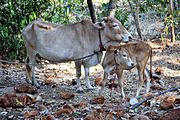Miniature cattle
Miniature cattle are found in various parts of the world. Some, such as the Dexter of Ireland and the Vechur of Kerala, India, are traditional breeds; others have been recently created by selective breeding. The Australian Lowline was the unexpected result of a scientific experiment.[1]: 3 Some, but not all, miniature breeds display achondroplasia, or dwarfism.[2]: xxvi
Compared to larger cattle, miniature cattle require less space and less feed,[3] and may be easier to handle.[4] They do less damage to pasture land, do not need such high or strong fencing,[5] and do not produce as much methane.[3]
Breeds[]
| Breed | Origin | Height/weight | Image |
|---|---|---|---|
| Achham | zebu, Achham District of Nepal[2]: 259 |
|
|
| Australian Lowline | derived from Aberdeen Angus in Australia[6] |
|

|
| Dexter | traditional Irish breed | 92–107 cm[7] | 
|
| Kasagarod | traditional breed, Kerala, India | 80–90 cm[2]: 322 | 
|
| or Dahomey | Benin, Congo, Côte d'Ivoire, Gabon, Togo |
|

|
| Miniature Texas Longhorn | United States | not over 115 cm[9] | |
| Miniature Zebu | modern breed register, United States |
|

|
| Niata | Uruguay, Argentina; now extinct[2]: xxvi | 
| |
| Punganur | Andhra Pradesh, India |
|

|
| Benin, Togo |
|
||
| Vechur | traditional breed, Kerala, India[2]: xxvi | 
|
An American breeder, Richard Gradwohl, has developed eighteen different strains of miniature cattle.[3] Miniature Galloway, Hereford and Holstein have been bred.[2]: 245 [3] In the United States, small zebuine cattle deriving from stock imported from Brazil, the Dominican Republic and Sweden may be registered as "Miniature Zebu";[2]: 245 in Australia, similar cattle may be known as "Nadudana".[citation needed] In the United States, Jersey cattle of the original island type may be known as "Miniature Jersey"; Jersey cows stand about 115–120 cm and weigh some 350 kg.[2]: 212
The Ethiopian Goffa and Guraghe breeds in the Abyssinian Shorthorned Zebu group are also small.[2]: 99
References[]
- ^ David Barnett (1998). History of Lowlines. In: Foundation Herd Book. Armidale, New South Wales: Australian Lowline Cattle Association.
- ^ a b c d e f g h i j Valerie Porter, Lawrence Alderson, Stephen J.G. Hall, D. Phillip Sponenberg (2016). Mason's World Encyclopedia of Livestock Breeds and Breeding (sixth edition). Wallingford: CABI. ISBN 9781780647944.
- ^ a b c d Rebecca Seal (25 July 2010). Why mini cows could save the planet. The Guardian. Accessed February 2017.
- ^ [Associated Press] (4 January 2006). Miniature Cattle Breed Interest. Los Angeles Times. Accessed February 2017.
- ^ Australian Lowline Cattle: A Rare Breed of Australian Origin. Rare Breeds Conservation Society of New Zealand. Accessed February 2017.
- ^ Breed data sheet: Lowline/Australia. Domestic Animal Diversity Information System of the Food and Agriculture Organization of the United Nations. Accessed February 2017.
- ^ Breed data sheet: Dexter/Ireland. Domestic Animal Diversity Information System of the Food and Agriculture Organization of the United Nations. Accessed February 2017.
- ^ Breed data sheet: Lagune/Benin. Domestic Animal Diversity Information System of the Food and Agriculture Organization of the United Nations. Accessed February 2017.
- ^ Regulations for registering Miniature Longhorns with the TLBAA. Texas Longhorn Breeders Association of America. Archived 28 July 2011.
- ^ Breed data sheet: India: Cattle: Punganur. Domestic Animal Diversity Information System of the Food and Agriculture Organization of the United Nations. Accessed February 2019.
- ^ Breed data sheet: Somba/Benin. Domestic Animal Diversity Information System of the Food and Agriculture Organization of the United Nations. Accessed February 2017.
- Cattle